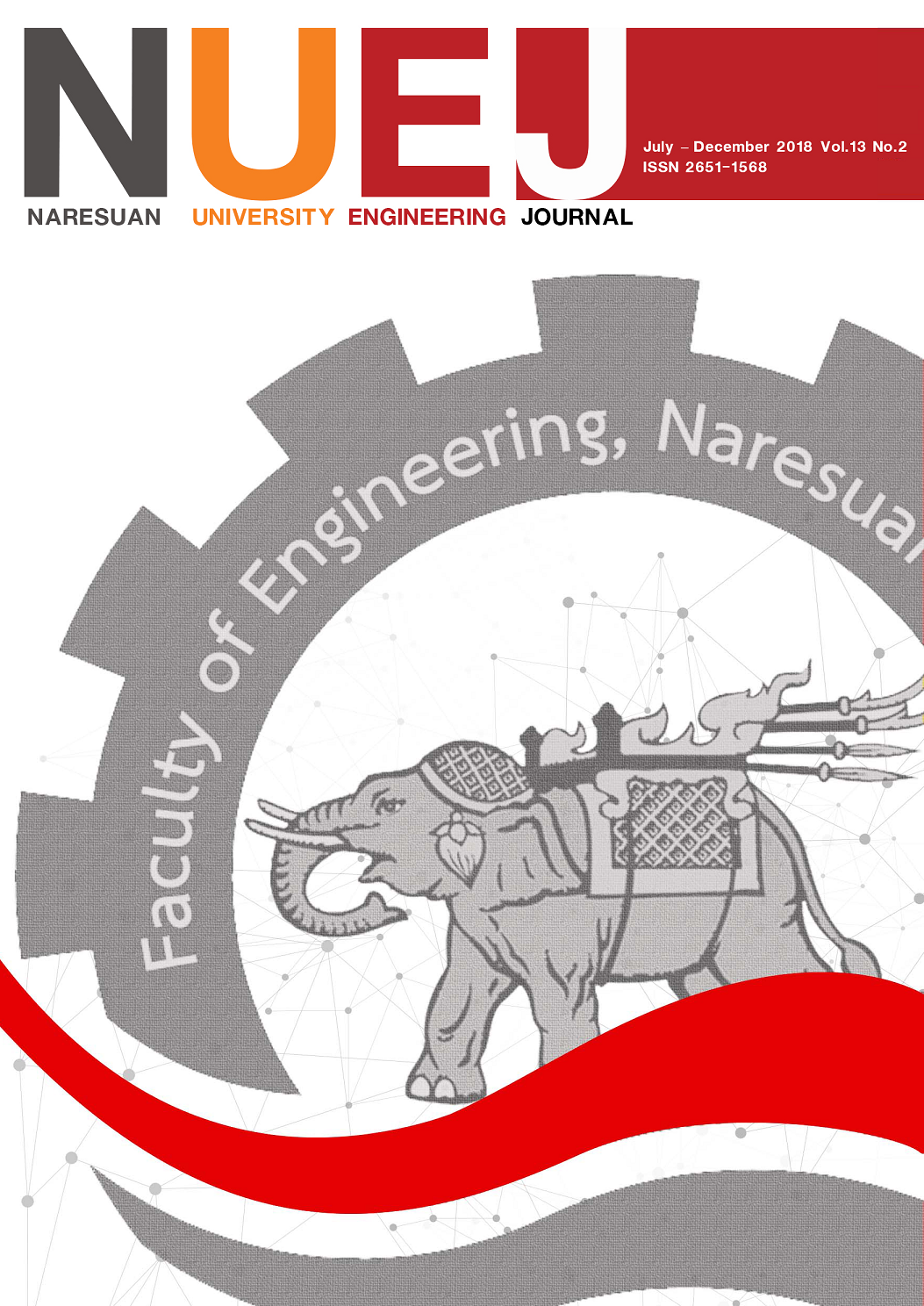การวิเคราะห์ความคุ้มค่าทางเศรษฐศาสตร์วิศวกรรมของโรงงานต้นแบบการผลิตบล็อกประสาน จากเถ้าหนักโรงไฟฟ้าแม่เมาะ
Main Article Content
บทคัดย่อ
งานวิจัยนี้มีวัตถุประสงค์เพื่อวิเคราะห์ต้นทุน และวิเคราะห์ความคุ้มค่าทางเศรษฐศาสตร์วิศวกรรมโรงงานต้นแบบการผลิตบล็อกประสานจากเถ้าหนักโรงไฟฟ้าแม่เมาะ เก็บรวบรวมข้อมูลปฐมภูมิในการผลิตบล็อกประสานจากโรงงานต้นแบบขนาดกำลังผลิต 1,000 ก้อนต่อวัน และใช้ข้อมูลทุติยภูมิจากเอกสารที่เกี่ยวข้องมาดำเนินการวิเคราะห์ต้นทุน และวิเคราะห์ความคุ้มค่าทางเศรษฐศาสตร์วิศวกรรมของโรงงานต้นแบบการผลิตบล็อกประสาน ด้วยวิธีการวิเคราะห์ผลตอบแทนจากมูลค่าปัจจุบันสุทธิ (NPV) อัตราผลตอบแทนภายในโครงการ (IRR) อัตราผลตอบแทนต่อต้นทุน (BCR) ระยะเวลาคืนทุน (PB) และวิเคราะห์ความอ่อนไหวของโครงการ กำหนดให้มีอายุการใช้งาน 10 ปี ผลการวิเคราะห์ พบว่า โรงงานต้นแบบการผลิตบล็อกประสานขนาดกำลังผลิต 1,000 ก้อนต่อวัน มีต้นทุนค่าใช้จ่ายในการลงทุนรวมเท่ากับ 2,027,000.00 บาท ต้นทุนค่าใช้จ่ายการดำเนินงานต่อปีเท่ากับ 1,707,200.00 บาท คิดเป็นต้นทุนรวมต่อหน่วย เท่ากับ 6.12 บาท และการวิเคราะห์ความคุ้มค่าทางเศรษฐศาสตร์วิศวกรรมที่อัตราคิดลดร้อยละ 3 และร้อยละ 7.12 พบว่ามูลค่าปัจจุบันสุทธิของโครงการ (NPV) เท่ากับ 7,465,205.13 และ 5,836,766.15 อัตราผลตอบแทนภายในของโครงการ (IRR) เท่ากับร้อยละ 60.51 และ 54.34 อัตราผลตอบแทนต่อต้นทุน (BCR) เท่ากับร้อยละ 1.45 และ 1.42 ตามลำดับโดยมีระยะเวลาคืนทุน (PB) เท่ากับ 18.85 เดือน ดังนั้นโครงการโรงงานผลิตบล็อกประสานจากเถ้าหนักโรงไฟฟ้าแม่เมาะ มีความคุ้มค่าในการลงทุน
Article Details
เอกสารอ้างอิง
[2] Electricity Generation Authority of Thailand (EGAT), (2016). Electricity Generation Department, Mae Moh Power Plant: Annual report on operations of ash and gypsum conveyor systems division, 2016.
[3] Electricity Generation Authority of Thailand (EGAT), (2016). Byproduct Sales and Contract Management Division, EGAT, Nonthaburi: Criteria and conditions for selling bottom ash Mae Moh power plant, 2016.
[4] Larpkiattaworn, S., (2018). Progress report #1 of the research project topic: The development of interlocking block pilot plant using by-product from Mae Moh power plant. pathumthani: Thailand Institute of Scientific and Technological Research (TISTR).
[5] The benefits of bottom ash to promoting community careers., available online: http://maemoh.egat.com/
index.php/93-new/315-252
[6] Kokkamhaeng, W., (2008). Training document; Production of quality interlocking blocks. Pathumthani: Expert Centre of Innovative Materials, Thailand Institute of Scientific and Technological Research (TISTR).
[7] Saisuthanawit, S. (2018).Development of interlocking block pilot plant using Mae Moh power plant ash. Master of Engineering Thesis Industrial Engineering, Chiangmai University. (in Thai)
[8] Thailand Institute of Scientific and Technological Research (TISTR), (2017). Documentation for the research and innovation development grant, Development of interlocking block pilot plant using by-product from Mae Moh power plant project. (in Thai)
[9] Choponsat A., Minaboon N. (2013). Interlocking block of waste concrete. Research of Rajamangala University of Technology Rattanakosin. (in Thai)
[10] Amonfa K., (2016). Engineering properties improvement of interlocking block by mixing with sand. Naresuan University Engineering Journal, Vol.11, No.1, January-June 2016, pp.67-73 (in Thai)
[11] Charoennatkul C., (2014). Interlocking blocks containing oil palm ash and shells waste. journal of community development and life quality. 2(1): 103-112.(in Thai)
[12] Dasaesamoh, A., Vaji, P., Salae, P., Naesae, N., (2015). Para rubber wood fly ash containing interlocking brick. journal of yala rajabhat university, Vol.10, No.1, January-June 2015, pp.77-86 (in Thai)
[13] Thubphan, Y., (2008). Project evaluation based on economics. Bangkok: Thammasat University Publisher.
[14] Sirisomboon, K., Panawon, K. (2016). Feasibility Study on Furnace and Drying Systems for Rubber Smoked Sheet. Engineering Journal Chiang Mai University, 23(2), 15-24. (in Thai).
[15] Thammasiri K., (2014). The economic and financial cost-benefit analysis of vehicle adoption: hybrid vehicle electric vehicle. Master of Economic Thesis Business Economic, Thammasat University. (in Thai)
[16] Laophungsak P., Jannachoo N., Ditwiroon N., (2013). Cost-Benefit Analysis of Sanpatong-Hangdong (Phase 1) Bypass Project, Chiangmai. Management Information Systems MIS Journal of Naresuan University, 6(2), 68-83. (in Thai)
[17] Jantaphan W., (2014). An Economic Worthiness Study of Residential Building Construction Project for Civil Servants and Employees of Nakhon Ratchasima Rajabhat University. (Master’s Thesis, School of Civil Engineering, Suranaree University of Technology). (in Thai)
[18] Boonlert, S. (2003). Cost and return on interlocking block manufacturing business in Chiang Mai provicre. Master of Accounting Independent study, Chiang Mai University. (in Thai)
[19] Evan, (2011). The value of business analytics: identifying the path to profitability. Hoboken new jersey: wiley.
[20] Brealey, Richard A., Stewart C. Myers, and Franklin Allen, (2014). Principles of corporate finance. New york: McGraw hill education.
[21] Thongsukhowong A., (2016). Cost accounting. Bangkok; SE-EDUCATION Public Company Limited.
[22] Savings Bonds of the Ministry of Finance in the fiscal year 2018 #2., available online: https://www.kasikornbank.com/th/promotion/Pages/SavingsBonds2.aspx
[23] Minimum Retail Rate: MRR., available online: https://www.ktb.co.th/Download/rateFee/RateFeeDownload_4194loan_05_10_60.pdf
[24] Nakruk, W., (2011). Decision-making under risk and uncertainty. Information Processing, Management and Application of Economics., Nonthaburi: Sukhothai Thammathirat Open University. (in Thai)


